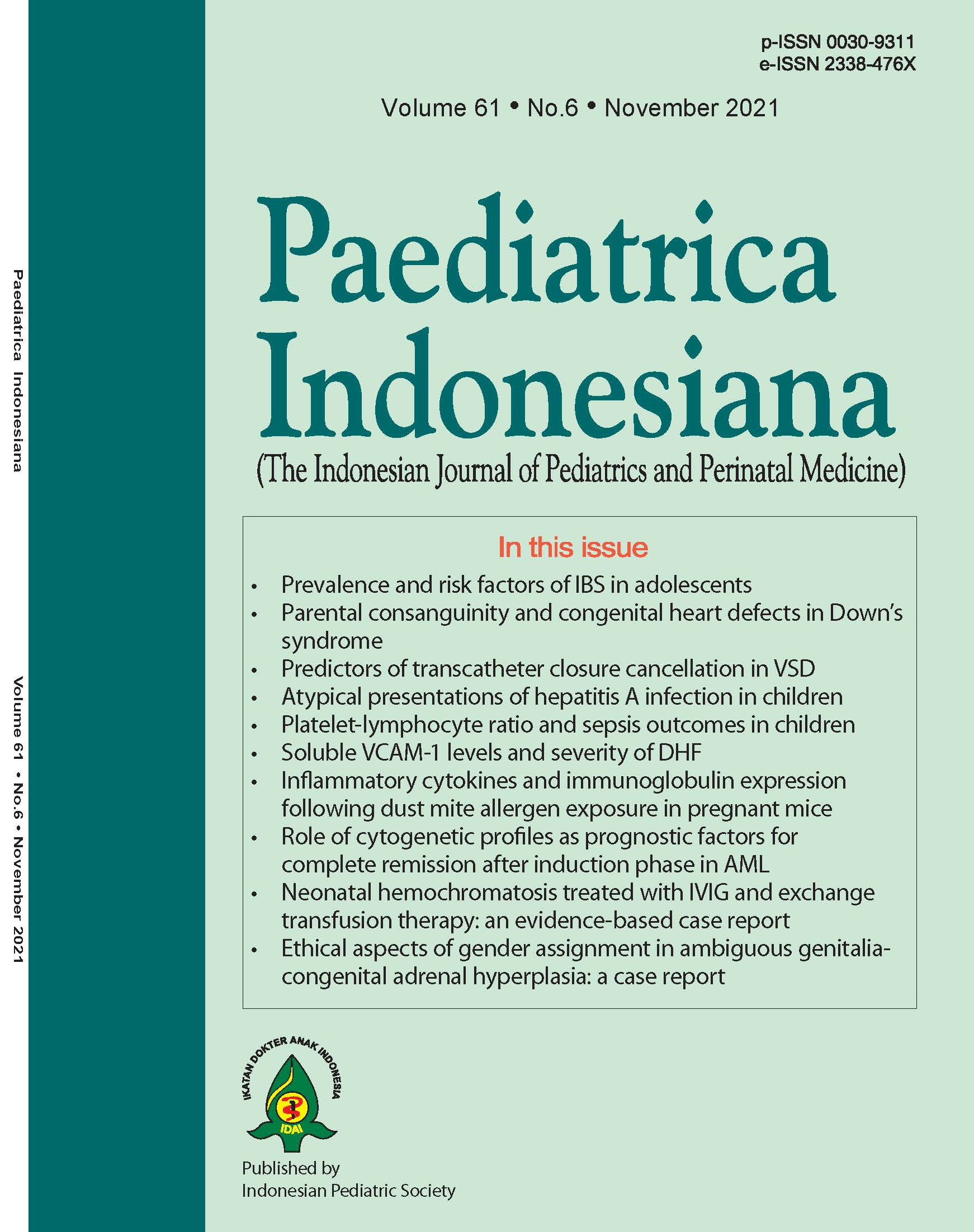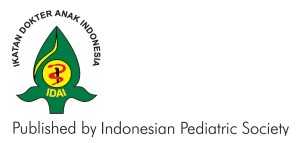Predictors of transcatheter closure cancellation in children with ventricular septal defect
Abstract
Background Ventricle septal defect (VSD) is the most common type of congenital heart disease in children. If definitive therapy delayed, failure to thrive and developmental delays can lead to decreased quality of life. The options for VSD closure include surgical and minimally invasive procedures with transcatheterization. Although transcatheterization is considered to be the safest therapy, the risk of complications can lead to cancellation of procedure.
Objective To determine whether nutritional status, body height, VSD type and size, and type of device used were predictors of cancellation of transcatheter closure of VSD.
Methods A retrospective cohort study using medical records was performed for all children who underwent transcatheter closure of VSD at Dr. Sardjito Hospital, Yogyakarta, Central Java, between January 2017 to March 2020. Cancellation of closure was defined as complications occurring during the procedure, such as cardiac conduction problems, valve regurgitation, and device embolization. Multivariate logistic regression analysis was done to determine independent predictors of closure cancellation.
Results One hundred thirty-four children were enrolled. Independent variables that were significant predictors were doubly committed subarterial (DCSA) VSD type (OR 5.98; 95%CI 1.52 to 23.61; P=0.045), moderate VSD size (OR 15.59; 95%CI 4.67 to 52.06; P=0.001), and types of devices used: symmetric (OR 27.06; 95%CI 2.75 to 266.17; P=0.001), asymmetric (OR 16.46; 95%CI 2.15 to 210.0; P=0.001), and coil (OR 21.26; 95%CI 2.15 to 210.0; P=0.001). Taller body height was a protective factor against cancellation of the procedure (OR 0.98; 95%CI 0.96 to 1.00; P=0.008).
Conclusion Significant predictors of cancellation of transcatheter VSD closure are DCSA VSD, moderate VSD size, as well as coil, symmetric, and asymmetric devices, and increased body height.
References
2. Musa NL, Hjortdal V, Zheleva B, Murni IK, Sano S, Schwartz S, et al. The global burden of paediatric heart disease. Cardiology in the young. 2017. 2017;27:S3-S8. DOI: 10.1017/S1047951117002530.
3. Sari NK, Soetadji A, Kosim MS. Hubungan antara Besarnya Defek Septum Ventrikel dengan Fungsi Paru. Sari Pediatr. 2016;16:189-94. DOI: 10.14238/sp16.3.2014.189-94.
4. Carminati M, Butera G, Chessa M, De Giovanni J, Fisher G, Gewillig M, et al. Transcatheter closure of congenital ventricular septal defects: Results of the European Registry. Eur Heart J. 2007;28:2361-8. DOI: 0.1016/j.amjcard.2005.09.068.
5. Feltes TF, Bacha E, Beekman RH, Cheatham JP, Feinstein JA, Gomes AS, et al. Indications for cardiac catheterization and intervention in pediatric cardiac disease: A scientific statement from the American Heart Association. Circulation. 2011;123:2607-52. DOI: 10.1161/CIR.0b013e31821b1f10.
6. Zhao LJ, Han B, Zhang JJ, Yi YC, Jiang DD, Lyu JL. Postprocedural outcomes and risk factors for arrhythmias following transcatheter closure of congenital perimembranous ventricular septal defect: A single-center retrospective study. Chin Med J (Engl). 2017; 130:516-21. DOI: 10.4103/0366-6999.200551 .
7. Mandal KD, Su D, Pang Y. Long-term outcome of transcatheter device closure of perimembranous ventricular septal defects. Front Pediatr. 2018; 6:128. DOI:10.3389/fped.2018.00128.
8. Radman M, Mack R, Barnoya J, Castañeda A, Rosales M, Azakie A, et al. The effect of preoperative nutritional status on postoperative outcomes in children undergoing surgery for congenital heart defects in San Francisco (UCSF) and Guatemala City (UNICAR). J Thorac Cardiovasc Surg. 2014; 147:442-50. DOI: 10.1016/j.jtcvs.2013.03.023.
9. Huang JS, Sun KP, Huang ST, Chen Q, Chen LW, Kuo YR. A meta-analysis of perventricular device closure of doubly committed subarterial ventricular septal defects. J Cardiothorac Surg. 2020; 15:28. DOI: 10.1186/s13019-020-1062-0.
10. Huang Y, Yan X, Lu L, Fang J, Sun X, Zhong L, et al. Transcatheter closure of doubly committed subarterial ventricular septal defects with the Amplatzer ductal occluder: Initial experience. Cardiol Young. 2019;29:570-5. DOI: 10.1017/S104795111900009X.
11. Ghosh S, Sridhar A, Solomon N, Sivaprakasham M. Transcatheter closure of ventricular septal defect in aortic valve prolapse and aortic regurgitation. Indian Heart J. 2018;70:528-32. DOI: 10.1016/j.ihj.2017.11.023.
12. Zhao J, Li J, Wei X, Zhao B, Sun W. Tricuspid valve detachment in closure of congenital ventricular septal defect. Texas Hear Inst J. 2003;30:38-41.
13. Andersen H, de Leval MR, Tsang VT, Elliott MJ, Anderson RH, Cook AC. Is Complete Heart Block After Surgical Closure of Ventricular Septum Defects Still an Issue? Ann Thorac Surg. 2006;82:948-56. DOI: 10.1016/j.athoracsur.2006.04.030.
14. Liu J, Wang Z, Gao L, Tan HL, Zheng Q, Zhang ML. A large institutional study on outcomes and complications after transcatheter closure of a perimembranous-type ventricular septal defect in 890 cases. Acta Cardiol Sin. 2013;29:271-6.
15. Sanz AP, Álvarez-Fuente M, Centella T, del Cerro MJ. Early complete atrioventricular block after percutaneous closure of a perimembranous ventricular septal defect with a Nit-Occlud (®) Lê VSD coil. Prog Pediatr Cardiol. 2018; DOI: 10.1016/j.ppedcard.2018.02.009.
16. Li P, Zhao XX, Zheng X, Qin YW. Arrhythmias after transcatheter closure of perimembranous ventricular septal defects with a modified double-disk occluder: Early and long-term results. Heart Vessels. 2012;27:405-10. DOI: 10.1007/s00380-011-0155-z.
17. Gu M, You X, Zhao X, Zheng X, Qin YW. Transcatheter device closure of intracristal ventricular septal defects. Am J Cardiol. 2011;107:110-3. DOI: 10.1016/j.amjcard.2010.08.053.
18. Roushdy AM, Abdelmonem N, El Fiky AA. Factors affecting vascular access complications in children undergoing congenital cardiac catheterization. Cardiol Young. 2012;22:136–44. DOI: 10.1017/S1047951111000989.
19. Roushdy AM, Abdelmonem N, El Fiky AA. Factors affecting vascular access complications in children undergoing congenital cardiac catheterization. Cardiol Young. 2012;22:136–44. DOI: 10.1017/S1047951111000989.
Copyright (c) 2021 Artha Christin Yulianti, Indah Kartika Murni, Noormanto Noormanto, Sasmito Nugroho

This work is licensed under a Creative Commons Attribution-NonCommercial-ShareAlike 4.0 International License.
Authors who publish with this journal agree to the following terms:
Authors retain copyright and grant the journal right of first publication with the work simultaneously licensed under a Creative Commons Attribution License that allows others to share the work with an acknowledgement of the work's authorship and initial publication in this journal.
Authors are able to enter into separate, additional contractual arrangements for the non-exclusive distribution of the journal's published version of the work (e.g., post it to an institutional repository or publish it in a book), with an acknowledgement of its initial publication in this journal.

This work is licensed under a Creative Commons Attribution-NonCommercial-ShareAlike 4.0 International License.
Accepted 2021-11-22
Published 2021-11-22











